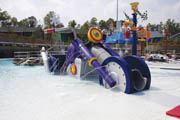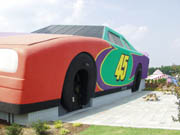
In an effort to create a paradise for kids, actor Paul Newman wanted a camp that would allow its attendees the opportunity to "kick back, relax and have lots of fun" with their families and other kids. This first camp, named the Hole in the Wall Gang Camp, was built in Ashford, Conn., and since, Newman has opened others in New York, California, Florida, Ireland and France.
In October 2000, noted NASCAR racer Kyle Petty and his wife Pattie partnered with Newman to launch the VJG, which is founded to honor the memory of the Petty's 19-year-old son Adam, who tragically died while at the New Hampshire International Speedway earlier that same year. After a study was conducted to determine whether there was a need for such a camp, statistics showed that more than 230,000 chronically ill children were in the Carolinas and Virginia areas. Thus, planning commenced.

Days of glory
To honor their son and the long lineage of NASCAR racers in the Petty family (Lee, Richard, Kyle and Adam), a camp was created with the NASCAR motif (several racers are partners and/or donators in the VJG)."A designer out of Texas contacted me and mentioned ... a project that he was interested in having us look at," says Richard Dowd, vice president of sales for Symmetry Products. "He was a little hush-hush about it, in the sense that he didn't really want to allude what was going on.
"So, I sent him half-a-dozen packets of our literature explaining the functions of out-of-the-ordinary projects that we've done, along with some photographs," Dowd continues. "He forwarded them to the Petty family. They in turn contacted me a month or two later, and asked me to go down there and present our products-and in turn presented us with the challenge to do the job."
The scope of the job was to create larger-than-life replicas of motorcycles, tire columns and Adam's Race Shop, which was a replica of Petty's car. Both Dowd and Vice President of Operations Earl Ferguson worked with the Petty family on the look of the car. Model cars ("the size of a Matchbox") were exchanged back and forth until the car was according to the specifications of the Adam Petty car. From there, the Symmetry team made the car in its Lincoln, R.I., facilities.
"We basically prefabbed the entire façade of the car here in the factory, basecoated most of it, set it all up again, and when everything fit, we broke it down, shipped it all on flat beds and installed it on site," says Ferguson. "Very similar to a typical panel system but it was a car."
"As far as building it, we took our panel experience with our EIFS experience and made these large panels that we shipped down here, and sculpted the EPS to all the contours," Dowd adds.
When being built and installed on site, every panel was an odd size and had "crazy" degrees to it. To add to the racing-car effect, the building (it actually has meeting rooms and administrative offices inside) is built on an angle to make it look like a car on a track.
The race car was built with metal stud panels, EPS and USeifs-brand EIFS, which made up the basic skin of all the walls. The roof was a sprayed foam polyurethane, like a typical roofing foam. The windshield and back window were skylights, done by Randy Sitzler, with Abbott Schlain, of Livonia, Mich. Beyond the countless contractors who also contributed to this labor of love, other friends found time to help.
"Richard Petty and Earl became friends," says Dowd. "He was extremely hands-on."
"He was a lot of fun dealing with," says Ferguson. "It got to the point where we needed some help on the motorcycle end in the pool one day, where we had to have some special stainless steel tools bent up. And me and this other guy down there were scratching our heads wondering what to do, you know, because we were out in the middle of nowhere. We found a piece of tube that we needed and we thought, ‘Where can we have it bent?' So we asked Richard and he took us up to his race shop and he said, ‘Just take what you need.'
"The job was very challenging but lots of fun," says Ferguson. "The people involved were great to deal with, the general contractor Shelco Inc., Camp Director Brian Collier and his entire crew, and Richard. He was the best-helpful in everyway and all of that made it a privilege, and an honor to be part of this project and its cause."
For more information on the camp, visit www.victoryjunction.org. It has other construction pictures/logs and further verbiage regarding the operation.




